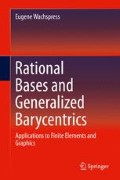Abstract
Motivation for generalization of the quadrilateral construction is stimulated by examination of the wedge associated with vertex 1 of this element. The simplest rational function that vanishes on (2;3)2 is
and we seek Q1 to make this function linear on sides (1;2) and (3;1) of the 3-con. Let Q1 = a + bx + cy. On (3;1), y = 0 and
For f1 to be linear on (3;1) with f1(x3, y3) = 0, we must have a = b. On side (1;2), x = 0 and
For f1 to be linear on (1;2) and f1(x2,y2) = 0, we must set a = c. When a = b = c:
Thus Q1 is the line on which 1 + x + y = 0, and a candidate for W1 is the function
Access this chapter
Tax calculation will be finalised at checkout
Purchases are for personal use only
References
H.S.M. Coxeter, Introduction to Geometry (Wiley, New York, 1961)
J. Ergatoudis, Quadrilateral elements in plane analysis. Masters thesis, University of Wales, Swansea, 1966
B.M. Irons, Numerical integration applied to finite element methods, in Conf. on use of Digital Computers in Structural Eng., University of Newcastle, 1966
R. McLeod, A.R. Mitchell, The construction of basis functions for curved elements in the finite element method. J. Inst. Math. Appl. 10, 382–393 (1972)
R. McLeod, A.R. Mitchell, The use of parabolic arcs in matching curved boundaries in the finite element method. J. Inst. Math. Appl. 16, 239–246 (1975)
G. Strang, G.J. Fix, An Analysis of the Finite Element Method (Prentice Hall, Englewood Cliffs, 1973)
Author information
Authors and Affiliations
Rights and permissions
Copyright information
© 2016 Springer International Publishing Switzerland
About this chapter
Cite this chapter
Wachspress, E. (2016). Rational Wedges for Selected Polycons. In: Rational Bases and Generalized Barycentrics. Springer, Cham. https://doi.org/10.1007/978-3-319-21614-0_3
Download citation
DOI: https://doi.org/10.1007/978-3-319-21614-0_3
Publisher Name: Springer, Cham
Print ISBN: 978-3-319-21613-3
Online ISBN: 978-3-319-21614-0
eBook Packages: EngineeringEngineering (R0)

